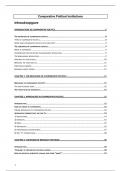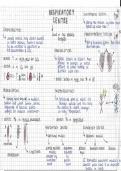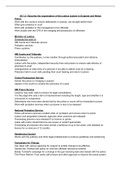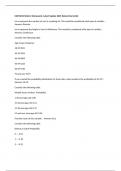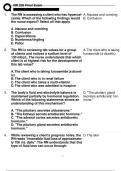Comparative Political Institutions
Inhoudsopgave
INTRODUCTION TO COMPARATIVE POLITICS.....................................................................................6
THE DEFINITION OF COMPARATIVE POLITICS................................................................................................8
TYPES OF COMPARATIVE POLITICS...................................................................................................................8
WHAT DOES COMPARATIVE POLITICS DO IN PRACTICE?........................................................................................9
THE SUBSTANCE OF COMPARATIVE POLITICS................................................................................................9
WHAT IS COMPARED?..................................................................................................................................9
COMPARATIVE POLITICS BEFORE THE BEHAVIORAL REVOLUTION.............................................................................9
THE BEHAVIOURAL REVOLUTION.....................................................................................................................9
AND BACK TO INSTITUTIONS........................................................................................................................10
BRINGING THE STATE BACK IN.......................................................................................................................11
MID-RANGE THEORIES................................................................................................................................11
RATIONAL CHOICE THEORY..........................................................................................................................11
CHAPTER 1: THE RELEVANCE OF COMPARATIVE POLITICS................................................................11
RELEVANCE OF COMPARATIVE POLITICS?..................................................................................................11
THE INSTITUTIONAL TURN...........................................................................................................................12
THE MANY FACES OF DEMOCRACY..........................................................................................................12
CHAPTER 2: APPROACHES IN COMPARATIVE POLITICS.....................................................................12
INTRODUCTION..................................................................................................................................12
USES OF THEORY IN COMPARISON..........................................................................................................12
MAJOR APPROACHES TO COMPARATIVE POLITICS.............................................................................................13
ALTERNATIVE PERSPECTIVES: THE FIVE I’S.................................................................................................13
1) INSTITUTIONS.......................................................................................................................................14
2) INTERESTS............................................................................................................................................15
3) IDEAS..................................................................................................................................................15
4) INDIVIDUALS.........................................................................................................................................16
5) INTERNATIONAL ENVIRONMENT................................................................................................................17
6) 6TH ‘I’?: INTERACTIONS.........................................................................................................................18
CHAPTER 3: COMPARATIVE RESEARCH METHODS............................................................................18
INTRODUCTION..................................................................................................................................18
‘TIMELINE’ OF METHODS IN POLITICAL SCIENCE.........................................................................................18
HOW DO POLITICAL SCIENTISTS USUALLY FIND THEIR “WHAT?”......................................................................19
1
,FROM WHAT TO HOW.........................................................................................................................21
QUALITATIVE RESEARCH – A BRIEF OVERVIEW............................................................................................24
COMPARING CASES AND CASE SELECTION.......................................................................................................24
CASESTUDIES............................................................................................................................................24
QUANTITATIVE RESEARCH – A BRIEF OVERVIEW.........................................................................................26
MEDIUM AND LARGE-N ANALYSIS................................................................................................................26
CASE SELECTION........................................................................................................................................26
CHAPTER 4: THE NATION STATE AND MULTICULTURAL CITIZENSHIP................................................27
CHAPTER 5: DEMOCRACIES..............................................................................................................27
DEFINITION OF DEMOCRACY.................................................................................................................27
MINIMALIST DEFINITION.............................................................................................................................28
MID-RANGE THEORIES................................................................................................................................28
MAXIMAL DEFINITION................................................................................................................................28
WHICH IS THE BEST?..................................................................................................................................29
CRITERIA FOR A “DEMOCRATIC” REGIME..................................................................................................29
DEMOCRACY – AS A PROCESS, NOT A GIVEN...................................................................................................32
CHAPTER 12: MULTILEVEL GOVERNANCE.........................................................................................33
CHAPTER 25: FROM DEMOCRACY PROMOTION TO DEMOCRACY PROTECTION...............................33
CHAPTER 6: AUTHORITARIAN REGIMES...........................................................................................33
DEMOCRACY – AS A PROCESS, NOT A GIVEN.............................................................................................33
THREE WAVES OF DEMOCRATIZATION.............................................................................................................33
DEMOCRATIC BACKSLIDING...................................................................................................................34
DEMOCRATIC BACKSLIDING: ITS FLUIDITY AND THE CONSEQUENES.......................................................................35
TOTALITARIAN REGIMES.......................................................................................................................36
BEYOND TOTALITARIANISM: UNDERSTANDING AUTHORITARIAN REGIMES.........................................................37
DIFFERENT TYPES OF AUTHORITARIAN REGIMES...............................................................................................37
DIFFERENCES BETWEEN TOTALITARIAN AND AUTHORITARIAN REGIMES..................................................................38
HYBRI REGIMES: A NEW TYPE OF NON-DEMOCRATIC, YET NON-AUTHORITARIAN REGIME.....................................39
CHAPTER 7: LEGISLATURES..............................................................................................................40
FUSED-POWER SYSTEM: THE CONGRESS...................................................................................................40
EXAMPLE: THE US SYSTEM.........................................................................................................................40
FUSED-POWER SYSTEM: PARLIAMENTARY SYSTEM......................................................................................43
EXAMPLE: THE ITALIAN SYSTEM....................................................................................................................44
2
,THE ROLE OF LEGISLATURES..................................................................................................................47
1) LEGISLATURE AS AGENT; LINKAGE, REPRESENTATION, AND LEGITIMATION..........................................................47
2) LEGISLATURE AS PRINCIPAL: OVERSIGHT AND CONTROL.................................................................................48
3) LEGISLATURE AS LEGISLATOR: POLICYMAKING VS POLICY-INFLUENCING.............................................................48
THE INTERNAL ORGANIZATIONAL STRUCTURES OF LEGISLATURES....................................................................48
ASSESSING A LEGISLATURE’S POWER.......................................................................................................49
CHAPTER 8: GOVERNMENTS AND BUREAUCRACIES.........................................................................50
TYPES OF GOVERNMENT......................................................................................................................50
GOVERNMENT AND THE SEPARATION OF POWERS............................................................................................50
PRESIDENTIAL GOVERNMENT.......................................................................................................................50
CABINET GOVERNMENT..............................................................................................................................50
PRIME MINISTERIAL GOVERNMENT................................................................................................................51
MINISTERIAL GOVERNMENT.........................................................................................................................51
THE AUTONOMY OF GOVERNMENT.........................................................................................................52
CHAPTER 9: CONSTITUTIONS, RIGHTS, AND JUDICIAL POWER.........................................................52
THE FRENCH POLITICAL SYSTEM.............................................................................................................52
BACKGROUND...........................................................................................................................................53
THE PRESIDENT.........................................................................................................................................54
THE NATIONAL ASSEMBLY: LEGISLATIVE POWER................................................................................................55
THE SENATE.............................................................................................................................................55
THE CONSTITUTIONAL COUNCIL...................................................................................................................55
THE GERMAN POLITICAL SYSTEM...........................................................................................................56
FEDERAL STATE..........................................................................................................................................56
THE CHANCELLOR......................................................................................................................................56
BUNDESTAG – PARLIAMENT........................................................................................................................57
BUNDESRAT – SENATE................................................................................................................................58
THE PRESIDENT.........................................................................................................................................58
THE CONSTITUTIONAL COURT......................................................................................................................59
CHAPTER 13: POLITICAL PARTIES.....................................................................................................59
INTRODUCTION..................................................................................................................................59
DEFINITION OF PARTY..........................................................................................................................60
THE FUNCTIONS OF PARTIES..................................................................................................................61
1. COORDINATION.....................................................................................................................................61
2. CONTESTING ELECTIONS..........................................................................................................................61
3. RECRUITMENT: POLITICAL PERSONNEL BELONG TO PARTIES.............................................................................61
4. REPRESENTATION...................................................................................................................................61
3
,MODELS OF PARTY ORGANIZATIONS........................................................................................................62
THE ORIGIN AND THE TRANSFORMATION OF POLITICAL PARTIES...........................................................................62
CADRE OF ELITE PARTIES.............................................................................................................................63
CARTEL PARTIES........................................................................................................................................63
CATCH-ALL PARTIES → CARTEL PARTIES..........................................................................................................64
CLASSIFYING POLITICAL PARTIES ACCORDING TO THE IDEOLOGY......................................................................65
WHEN WERE THESE CONCEPTS FORMED?.......................................................................................................65
CHAPTER 18: POLITICAL PARTICIPATION..........................................................................................66
THE ORIGIN OF PUBLIC OPINION............................................................................................................66
MOBILIZATION AND POLITICAL ORGANIZATIONS...............................................................................................66
HOW? MODES OF POLITICAL PARTICIPATION.............................................................................................67
SITES OF PARTICIPATION..............................................................................................................................67
WHY? DETERMINANTS OF POLITICAL PARTICIPATION..................................................................................67
WHEN AND WHERE?...........................................................................................................................68
WHO? EXPLAINING POLITICAL PARTICIPATION AT THE MICRO LEVEL................................................................68
CHAPTER 16: SOCIAL MOVEMENTS..................................................................................................69
DEFINITION OF SOCIAL MOVEMENT: MAIN FEATURES......................................................................................69
INTERNAL AND EXTERNAL ACTIVITIES.............................................................................................................70
SOCIAL MOVEMENTS AND THE DIGITAL REVOLUTION.........................................................................................70
SOCIAL MOVEMENTS AND DEMOCRATIC PARTY SYSTEMS....................................................................................71
SOCIAL MOVEMENTS AND ELECTIONS............................................................................................................71
MOBILIZATIONS AS OF TODAY ARE FAR LESS THAN MOBILIZATIONS IN THE PAST. CIVIL-RIGHTS IN THE US IN THE SIXTIES 71
CHAPTER 14: PARTY SYSTEMS..........................................................................................................72
PARTY SYSTEMS: DO NOT TAKE THEM FOR GRANTED...................................................................................72
PARTY SYSTEMS AS A RECENT “EUROPEAN” CREATION”...............................................................................72
THE NATIONAL AND INDUSTRIAL REVOLUTIONS................................................................................................72
THE RISE OF CLEAVAGES IN EUROPE........................................................................................................73
WHAT IS A CLEAVAGE?...............................................................................................................................73
1. CENTRE-PERIPHERY................................................................................................................................74
2. STATE-CHURCH.....................................................................................................................................74
3. LAND-INDUSTRY (RURAL-URBAN).............................................................................................................74
4. OWNERS-WORKERS...............................................................................................................................74
THE KEY ACTORS IN CLEAVAGE THEORY...........................................................................................................75
THE NEW CLEAVAGE STRUCTURE IN WESTERN EUROPE.....................................................................................76
5. COMMUNIST-SOCIALIST CLEAVAGE............................................................................................................76
6. MATERIALIST VS. POST-MATERIALIST CLEAVAGE...........................................................................................76
4
,7. GLOBALIZATION WINNERS VS. GLOBALIZATION LOSERS CLEAVAGE....................................................................76
CLEAVAGES, AND WHAT TO (NOT) EXPECT FROM THEM.....................................................................................77
THE MORPHOLOGY OF PARTY-SYSTEMS....................................................................................................77
DOMINANT-PARTY SYSTEM..........................................................................................................................78
TWO-PARTY SYSTEM...................................................................................................................................78
MULTI-PARTY SYSTEMS...............................................................................................................................78
MODERATE MULTI-PARTY SYSTEMS................................................................................................................79
POLARIZED MULTI-PARTY SYSTEMS................................................................................................................79
BIPOLAR SYSTEMS......................................................................................................................................79
THE DYNAMICS OF PARTY-SYSTEMS.........................................................................................................80
INTRA-PARTY DEMOCRACY..............................................................................................................80
CANDITATE SELECTION.........................................................................................................................82
GENDER AND POLITICS....................................................................................................................83
REPRESENTATION...............................................................................................................................83
1. FORMALISTIC REPRESENTATION.................................................................................................................83
2. DESCRIPTIVE REPRESENTATION..................................................................................................................83
3. SYMBOLIC REPRESENTATION.....................................................................................................................83
4. SUBSTANTIVE REPRESENTATION.................................................................................................................83
HOW DO WOMEN GET IN PARLIAMENT?..................................................................................................84
GENDER QUOTA: 3 FORMS..........................................................................................................................84
CHAPTER 11: ELECTORAL SYSTEMS AND REPRESENTATION..............................................................85
ELECTORAL SYSTEMS...........................................................................................................................85
BUILDING BLOCKS OF ELECTORAL SYSTEMS......................................................................................................86
TYPES OF ELECTORAL SYSTEMS...............................................................................................................87
1. MAJORITARIAN FAMILY...........................................................................................................................87
2. PROPORTIONAL REPRESENTATION SYSTEM (PR)...........................................................................................87
LIST SYSTEM METHODS: D’HONDT METHOD – HIGHEST AVERAGE.......................................................................88
SAINT-LAGUE: PROPORTIONAL REPRESENTATION..............................................................................................88
DELEGATES VS TRUSTEES.............................................................................................................................89
TYPES OF REPRESENTATION..........................................................................................................................89
REFERENDA IN EUROPE – DIRECT DEMOCRACY AND IT’S USE........................................................................89
5
, LECTURE 1 & 2
Introduction to comparative politics
Examen:
Part 1 - 50%:
- 40 closed questions on syllabus + slides → mentioned but not part of the chapters ≠
required to study, but the content of the PPT is
- Multiple choice
- Matching columns
- Filling in a missing word
- Correct answer = 0.5 point
- Multiple answer options possible (if he asks for it, there will definitely be more than
one correct answer!!) if you then mark only one, you get 0
- If he says mark the correct answer, then there is only one correct answer
- No correction for guessing
Part 2 - 50%:
- 20 closed questions about one of the two books (you can choose which book)
o (How Democracies Die (Levitsky, Steven & Ziblatt))
o (The Democratic Regression. The Political Causes of Authoritarian Populism
(Schafer, 1 & Zurn))
- You can ask questions about the books, but they won't be discussed in the lecture
- Will be broad questions, not about details in the book. Just need to know the main
things.
- Closed questions (you can’t bring your book)
→ 1h 45 min
Chapters from book:
Introduction + Ch 1, 2, 3, 5, 6, 7, 8, 9, 11, 12, 13, 14, 17, 18 & 25
Poltical science = jonge wetenschap (20ste eeuw)
This course:
How poltics changed since the transition to mass democracy in the nineteenth century
→ the long)term comparative study of politics
Definition comparative political institutions:
- COMPARATIVE: refers to the methodology (how)
- POLITICAL/politics: what is the field of research.
- INSTITUTIONS: stable, valued, recurring patterns of behavior created by humans
(socially constructed).
6
,Formal institutions= constitutions, laws, international treaties, written rules, codes
Most important characteristics:
- Transparancy (potentially open to scrutiny, can also be changed)
- Approach to rules (rule-of-law)
- Character of rules (written→ e.g. the constitution)
→ Exception: there are constitutions that are not written: e.g. In Great-Brittain: habits
Informal institutions= socially shared rules, usually unwritten, that are created,
communicated, and enforced outside of officially sanctioned channels.
Respect, loyalty, honour, clan politics, clientelism1, social trust (even superstition)
Definition: politics
= The human activity of making collective authoritative decisions.
It is the activity of acquiring the power of making such decisions and of exercising this power.
It is the conflict for power add its use.
→ who decides what, and how, is important for the life of societies.
They apply to:
- Everyone who is part of a given community.
- Living in a specific territory/area (religion, environment, economy, …)
Collective: because they may concern every aspect of society’s life
Public: because it applies to all citizens. We are not interested in what
people/organizations do in the private sphere.
Authoritative: because the government that makes such decisions hast the power to
make them binding & they can sanction individuals who do not comply.
Who makes the decisions & how are they made?
The way in which public & authoritative decisions are made varies a great deal:
- In democracies: citizens are directly involved through elections/referenda.
- In authoritarian regimes: individuals are excluded.
Why is politics important?
Because man is by nature a political animal (a social animal, that lives in complex societies)
→ studying politics is also studying the ‘manhood’ in a way.
1
Clientelism= = exchange between canditate & voter, they give something & get something in return
≠ formalised, is not in written form (because it is illegal)
7
, Definition: power
= the ability of an individual or a group of individuals to achieve their own goals, when others
are trying to prevent the to realise them
→ the ability of forcing other people to do things that they wouldn’t do otherwise.
3 types of power:
I. Traditional (Patriarchy, kings, …)
II. Charismatic (Leaders)
III. Rational-legal (State)
The definition of comparative politics
Normative & theoretical
questions
Comparative politics: empirical questions & value neutral
Definition: comparative politics
= one of the 3 main subfields of political science (2 & 3: political theory & international
relations), focusing on internal political structures, actors & processes and analyzing them
empirically by describing, explaining and predicting their variety across political systems,
regional, municipal of even supranational systems.
Comparative politics: Interactions within political systems
E.g. what king of electoral constituency2 had supported this party?
International relations: Interactions between political systems
Is always a-normative: doesn’t differentiate between good & bad
Everyone is biased, but we are not judging on good or bad, no evaluations
= distinction tussen comparative politcs-scientist & a journalist for example can write
collums about what they think about certain political parties
Types of comparative politics
Three traditions:
1) Study of single countries
2
Constituency= the group of people backing something or someone
8

